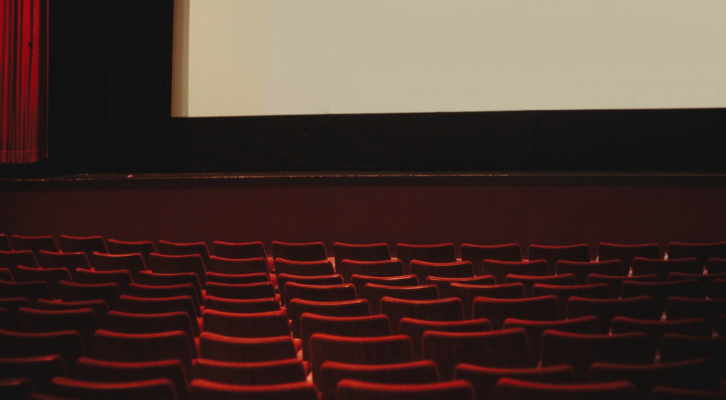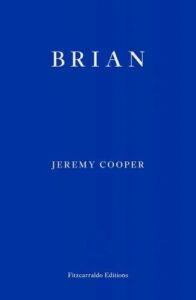
Fact, Fiction, and Film: Jeremy Cooper on Creating Verisimilitude
"Like an iceberg, more lies below the surface than is visible on the printed page."
My novel Brian is centered on the thoughts and feelings of a single character and follows the relatively uneventful trajectory of his adult life. He is a solitary figure, living alone in rented rooms in North London, who, after a visit to the British Film Institute on the Southbank, finds joy in cinema, soon going to a movie at the BFI all seven nights of the week, two films an evening on retirement. Becoming a buff puts him in contact a small group of other dedicated filmgoers and the novel charts the tentative development of friendship with one of the regulars. Restrained isolated men such as Brian seldom feature in fiction and yet, treated with authorial care and empathy, the story of his life touches wider human concerns.
In a novel based around a film buff, actual films naturally play a part in structuring the narrative. Like novels, films mean different things to different people, provoke contrasting responses. My wish was to describe the many movies mentioned in Brian in a form which reflected the emotions of my central character, whilst also communicating accurately something of the films’ original essence, and at the same time not undermining cinemagoers’ individual memories of the work. To achieve this I needed my text to have a certain openness and freedom from rigidity. Although the chronology is accurate and all the films titled and attributed correctly, the narrative style allows for focus often on lesser-known aspects and for the insertion of mild inventions. Told entirely from close to the closed point of view of Brian, the isolated buff, the book’s views on life in general and film in particular are his.
The merging in Brian of fact and fiction is designed not to confuse readers but to liberate them.
Brian aims to be seen as “true” in two divergent ways, in the convincing depiction of an obsessive central character and in acceptable portrayal of actual films and other public events. The novel assumes overlapping areas of unity between fact and fiction, for even in the driest documentary re-telling of an historical episode choices are made—in the language of description, in what to leave out, in presentational design, and as to which external experts to trust on disputed issues. There is inevitably an element of fiction in all factual writing, because the taste and judgement of an individual has informed its composition. In reverse, almost all fiction has a factual core, colored by the life of its writer, by the people they have come across, and by the underlying emotional tenor of the author’s interests. Whether by intention or not, a novel in part documents its writer, at times with the deliberate contradiction of openness versus restraint and verbal shimmer against solid realism.
Aspects of Brian’s life are drawn from my own, all except three of the one hundred and sixty-six films mentioned in the book having been seen by me in a public cinema sometime during the last forty years, mostly at the BFI. Despite this weight of naming, the book is written on the assumption of no previous knowledge of film and does not involve conventional film criticism. Selective movie lore and habits appear in the text and, because of the wide focus of Brian’s interests, Brian is incidentally informative about film history. The book explores the imagined life of a fictional film buff, written by a film enthusiast for whom cinema is only a secondary concern, other subjects taking a central place in my life. Not being a buff myself, a number of the seemingly “expert” details are in fact invented—though in conversation the other day I was surprised and delighted to hear that my fictional creation of the Get Carter Club was historical fact. Conversely, another reader was convinced that my narrative around Brian’s research on Ozu’s Tokyo Story was the historical truth rather than the informed invention it actually is. I find it satisfying to learn that that perception by knowledgeable readers of the difference between fact and fiction can is so liquid.
My six other novels were also about subjects of long-term personal interest, none of them requiring research beyond my own library, ephemera file and memory. Large parts of the text of Brian speak equally for the fictional protagonist and for me, his inventor, especially in shared views on the nature of cinema. This excerpt, for example, is as true for me as for Brian:
The thing about the cinema, in Brian’s experience, seated in a large dark space staring without interruption at a high wide screen, entranced, lost in another’s vision, was that he found feelings inside himself he did not know existed, replaced the next night by a different film and new sensations. And the next. Another film, another set of feelings.
None of it was about him, all about the movie.
Many of the stories told of public appearances by key directors—Werner Herzog, for instance, and Derek Jarman—did indeed happen much as described, witnessed by me and reassigned to Brian. Plenty of other stuff is Brian’s alone, including his every-night BFI ritual, his Northern Irish background, and his various medical problems. Other Brian connections are a fictive mix of my experiences—such as Lorenzo at Il Castelletto, where Brian has lunch every day, drawn from four Italian cafés I enjoyed at different times during my thirty years living in London, in Clerkenwell, Kentish Town, Bethnal Green and Bloomsbury.
I find it satisfying to learn that that perception by knowledgeable readers of the difference between fact and fiction can is so liquid.
The merging in Brian of fact and fiction is designed not to confuse readers but to liberate them. What matters to me is not whether the so-called facts in a novel are so-called true but the independent integrity of the work as a whole. The necessary questions to ask, in my opinion, are: do depictions of the characters and happenings convince in themselves; and does the text construct a fictional edifice which functions effectively within its own terms? The decision to use real films—only two were made up, but right now I cannot recall which—was in order to provide the many cinemagoers who are also readers with a sense of confidence in the text, allowing them to concentrate on Brian’s struggle to follow a safe path through life. In added emphasis to the interchange between fact and fiction, on occasion occurrences which sound invented turn out to be historically accurate and, by contrast, seemingly true events never actually took place. In the first category The Articultural Show, described as performed on the terraces of the Southbank in summer 1999, tends to be read as an invention. In fact it occurred much as described in the novel, organized by a friend and neighbor of mine, the artist Gavin Turk, who designed and printed Sheep notes for obligatory use at every stall, even to buy a coffee or beer. On the other hand, the Design Museum’s exhibition Inventing Ziggy Stardust at Butler’s Wharf, with Brian’s description of actual film memorabilia, may sound convincing but is an authorial conceit.
Like an iceberg, more lies below the surface than is visible on the printed page. The reason, in my style of writing, is often a question of balance, the desire not to weigh down the reader with gratuitous information. The rhythms of the sentences and the currents of language within the text are underscored by a flow of material which is not physically seen. Brian is full of hidden histories, personal and general.
__________________________________

Brian by Jeremy Cooper is available from Fitzcarraldo Editions.
Jeremy Cooper
Jeremy Cooper is a writer and art historian, author of six previous novels and several works of non-fiction, including the standard work on nineteenth century furniture, studies of young British artists in the 1990s, and, in 2019, the British Museum’s catalogue of artists’ postcards. Early on he appeared in the first twenty-four of BBC’s Antiques Roadshow and, in 2018, won the first Fitzcarraldo Editions Novel Prize for Ash before Oak.



















